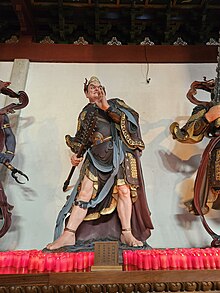Twelve Heavenly Generals
Appearance
InEast Asian Buddhism,theTwelve Heavenly GeneralsorTwelve Divine Generalsare the protective deities, oryaksha,ofBhaisajyaguru,thebuddhaof healing. They are introduced in the Medicine Buddha Sutra orBhaiṣajyaguruvaidūryaprabharājaSūtra.[1] They are collectively named as follows:
- simplified Chinese:Mười hai thần tướng;traditional Chinese:Mười hai thần tướng;pinyin:Shí'èr Shén Jiāng
- Japanese:Jūni Shinshō(Mười hai thần tướng)orJūni Shinnō(Mười hai thần vương)orJūni Yakusha Taishō(Mười hai dược xoa đại tướng)[2]
Names of generals[edit]
The precise names of the generals seem to vary depending on tradition. Those listed below are from an available Sanskrit transcription of theBhaiṣajyaguruvaiḍūryaprabhārāja Sūtra:[3]
| Sanskrit | Hanzi | Pinyin | Rōmaji | Vietnamese | Tagalog | Tibetan (Wly.) | Zodiac | Zodiac (Japan)[4] | Honji |
|---|---|---|---|---|---|---|---|---|---|
| Kiṃbhīra | Cung bì la | Guānpíluò Jīnpíluò |
Kubira Kompira(Shinto) |
Cung Tỳ La | Kimbhila | Ji 'jigs | Boar | Rat | Maitreya |
| Vajra | Phạt chiết la | Fázhéluò | Basara, Bazara | Phạt Chiết La | Vajla | Rdo rje | Dog | Ox | Mahāsthāmaprāpta |
| Mekhila | Mê xí la | Míqǐluò | Mekira | Mê Súy La | Mekhila | Rgyan 'dzin | Rooster | Tiger | Amitābha |
| Antila | An đế la | Āndǐluò | Anchira, Anteira | An Để La | Antila | Gza' 'dzin | Monkey | Rabbit | Avalokiteśvara |
| Anila | Át 儞 la | Ènǐluò | Anira | Át Nể La | Anila | Rlung 'dzin | Sheep | Dragon | Mārīcī |
| Saṇṭhila | San đế la | Shāndìluò | Sanchira, Santeira | San Để La | Santhila | Gnas bcas | Horse | Snake | Ākāśagarbha |
| Indala | Nhân đạt la | Yīndàluò | Indara | Nhân Đạt La | Indala | Dbang 'dzin | Snake | Horse | Kṣitigarbha |
| Pāyila | Sóng di la | Bōyìluò | Haira | Bà Di La | Payila | Gtun 'dzin | Dragon | Sheep | Mañjuśrī |
| Mahāla | Ma hổ la | Mòhǔluò | Makora | Ma Hổ La | Mahala | Sgra 'dzin | Rabbit | Monkey | Yamantaka[5] |
| Cidāla | Thật đạt la | Zhēndàluò | Shindara | Chân Đạt La | Sidala | Bsam 'dzin | Tiger | Rooster | Samantabhadra |
| Caundhula | Chiêu đỗ la | Zhāodùluò | Shōtora | Chiêu Đổ La | Saundhula | 'dzin | Ox | Dog | Vajrapāṇi |
| Vikala | Bì yết la | Píjiéluò | Bikara Bigyara |
Tỳ Yết La | Bikala | Rdzogs byed | Mouse | Boar | Śākyamuni |
Descriptions of each Heavenly General[edit]
Zhendaluo ( chiêu đỗ la )[edit]
 |
Short description about Zhendaluo |
Zhaoduluo ( chiêu đỗ la )[edit]
 |
Short description about Zhaoduluo |


While theHonjiand zodiac correspondences listed above are the standard in Japanese sources, there is variation among texts and regional traditions.[6]
Popular culture[edit]
- Statues of the Twelve Heavenly Generals stand inNgong Ping,Hong Kong.
- The Heavenly Generals all appear as Boss characters in 1994 video gameShin Megami Tensei II.They are depicted as servants ofĀṭavaka,and share the unique classification "Shinshou".
- The Heavenly Generals and their names were used as character material for the powerful digital monster characters who serve the "Four Holy Beasts" (Digimon Sovereigns in the English Dub) in the Digital World, from the 2001 seriesDigimon Tamers,albeit with the names mismatched, due to being based on the Japanese zodiac classification.
- Granblue Fantasystarted to release series of playable units in 2015 which called "The 12 Divine Generals". Each of these units are named after the corresponding zodiac they represent. The Japanese version use adapted Hepburn romanization, while the English version adapted from Sanskrit.
- Jujutsu Kaisenintroduced Mahāla as a summon for one of the Ten Shadows technique, dubbing it the "Eight-Handled Sword Divergent Sīla Divine General Makora," which was mistranslated as "Mahoraga," despite the furigana for the both of them being distinct. A golden cursed tool with the power of lightning, and shaped similarly to adornments of the electric-themed Vajra named “Kamutoke” also makes an appearance.
References[edit]
- ^Mary Neighbour Parent (2001)."JAANUS - Japanese Architecture and Art Net Users System".Japanese Architectural and Art Historical Terminology(online ed.).Retrieved2009-04-20.
- ^Mark Schumacher."12 Divine Generals of Yakushi Buddha".A to Z Photo Dictionary: Japanese Buddhist Statuary.Retrieved2009-06-24.
- ^"Bhaiṣajyaguruvaidūryaprabharājasūtram".Digital Sanskrit Buddhist Canon.Retrieved2019-03-02.
- ^"Twelve Heavenly Generals of Yakushi Buddha (source: Ancient Buddhism in Japan, Vol. II (Leiden: 1935, pp. 551-553))".BUDDHISM & SHINTŌ IN JAPAN.Retrieved2022-09-16.
- ^Đặt lại tân bản, thế giới đại bách khoa sự điển nội ngôn cập, tinh tuyển bản nước Nhật ngữ đại từ điển,デジタル đại từ tuyền, đặt lại tân bản thế giới đại bách khoa sự điển, Nhật Bản đại bách khoa toàn thư (ニッポニカ), bách khoa sự điển マイペディア,ブリタニカ quốc tế đại bách khoa sự điển tiểu hạng mục sự điển, sơn xuyên Nhật Bản sử tiểu từ điển."Mười hai thần tướng (じゅうにじんしょう)とは? Ý vị や sử い phương".コトバンク(in Japanese).Retrieved2024-04-10.
{{cite web}}:CS1 maint: multiple names: authors list (link) - ^"Dược sư mười hai thần tướng".Flying Deity Tobifudo.Retrieved2019-03-02.

